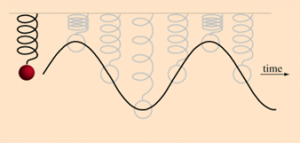Simple Harmonic Motion:
The Vernier physics activity titled Simple Harmonic Motion shows students how sinusoidal functions appear in the world around them.
This activity fulfills the following Common Core State Standards:
CCSS.MATH.CONTENT.HSF.TF.B.5
Choose trigonometric functions to model periodic phenomena with specified amplitude, frequency, and midline.*
Create equations in two or more variables to represent relationships between quantities; graph equations on coordinate axes with labels and scales.
Students often learn trigonometry but fail to recognize how often it shows up in their lives. Since it seems like all trigonometry is, is playing with triangles and some weird graphs that never actually show up in real life, it is easily forgotten. This lab will help them understand both how applicable trigonometry is and how to manipulate trigonometric functions. This will be done by recording the position and velocity of an object at the end of an oscillating spring using Verniers motion detector in conjunction with a computer that has Logger Pro software on it. The students will experiment with their springs motion when different weights are attached to. A ready prepared lab will lead them though this experiment and help them make connections between simple harmonic motion.
The equipment needed for this activity is the following:
- computer ring stand
- rod
- right-angle clamp
- Vernier computer interface Logger Pro
- Vernier Motion Detector spring with a spring constant of approximately 15 N/m
- twist ties
- 200 g and 300 g masses
- wire basket
- lab worksheet (attached below)
Many of these items can be borrowed from Central Washington University’s CESME department.
PWV-15-COMP-simple_harmonic_motion
